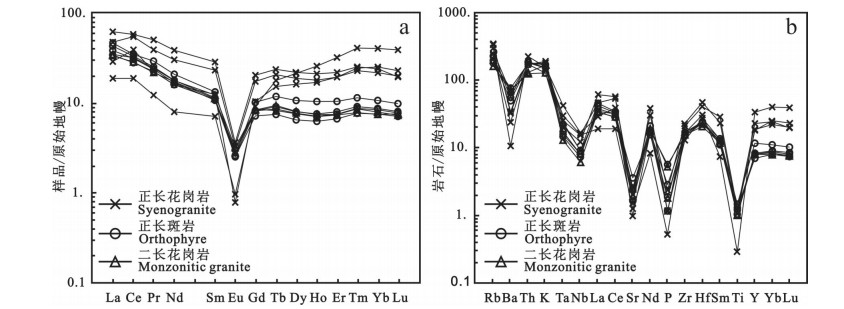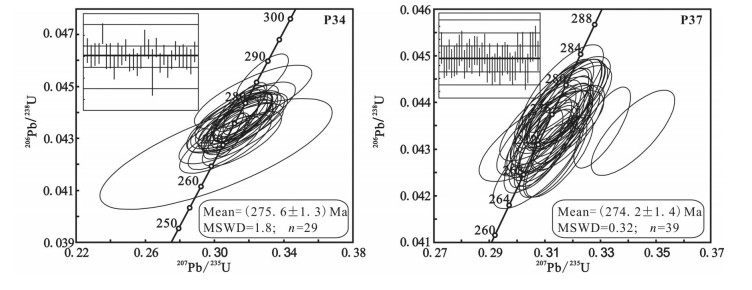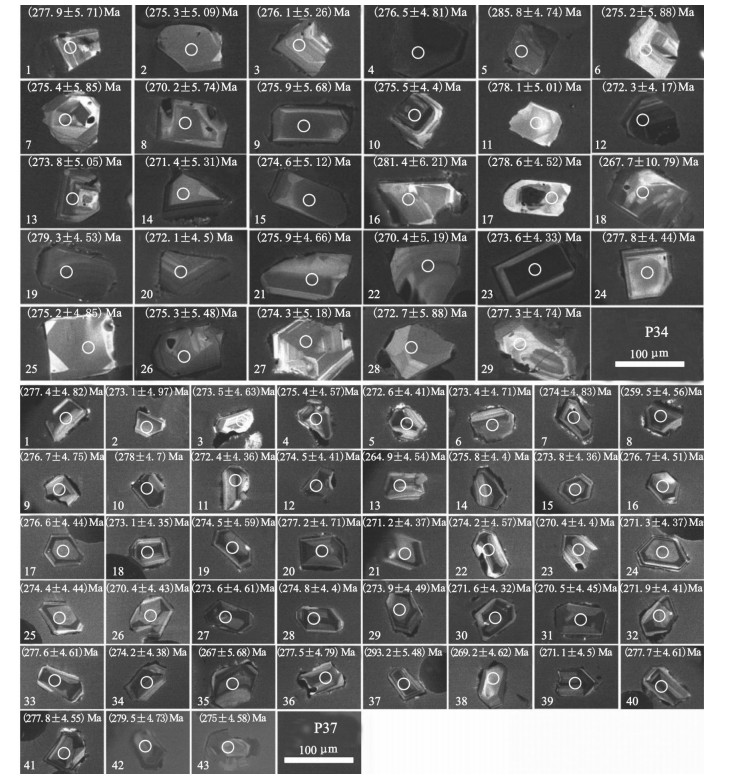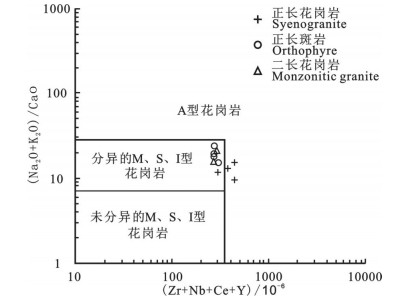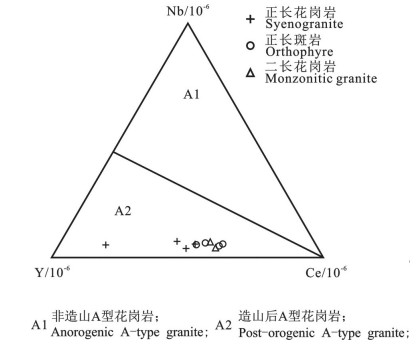The genesis and dating of the Early Permian granitic rock in the north of Xilin Hot, Inner Mongolia
-
摘要:
内蒙古锡林浩特北部朝克乌拉山附近分布有早二叠世花岗岩类,可作为兴蒙造山带东部构造-岩浆活动的研究载体。本文通过对花岗岩类进行岩相学、岩石地球化学、锆石U-Pb年代学的研究,讨论其岩石成因、构造环境。早二叠世侵入岩岩性主要为正长花岗岩、二长花岗岩、正长斑岩。地球化学上,岩石具有高硅、富碱、贫钙、贫镁的特点,属于偏铝—过铝质碱性花岗岩。轻重稀土元素存在一定程度的分馏,总体表现出轻稀土相对富集、重稀土相对亏损,具有明显的负Eu异常,Rb、Th、K、La、Ce、Nd、Zr、Hf、Sm元素明显富集,Ba、Ta、Nb、Sr、P、Ti元素显著亏损。岩石的锆石饱和温度为802℃,具有低Sr高Yb特征,指示岩体形成于高温低压环境,结合岩石地球化学表明岩体属于铝质A型花岗岩,其源岩与岛弧岩浆作用有关。锆石U-Pb测年结果为(275.6±1.3)Ma(正长花岗岩)、(274.2±1.4)Ma(正长斑岩),表明岩体形成时代为早二叠世晚期。结合区域上阿木山组中安山岩夹层的锆石U-Pb年龄,古生物、花岗岩证据表明晚石炭世至早二叠世晚期,贺根山洋闭合并完成了板块碰撞挤压到碰撞伸展的转换。
Abstract:The Permian granitic rock near the Chaokewula Mountain in the north of Xilin Hot area are very important for the study of the structural and magmatic acitivities in eastern Xing'an-Mongolian orogenic belt. The purpose of this study is to discuss the petrogenesis and tectonic setting based on detailed investigation of petrography,litho-geochemical characteristics and zircon U-Pb chronology of the granitic rock. The rocks are mainly composed of syenogranite,monzonitic granite and orthophyre. Geochemically,the granites are characterized by rich silicon and alkalis as well as depletion of calcium and magnesium,thus belonging to aluminous-peraluminous alkali granite. The rare earth elements demonstrate a slightly high degree of fractionation,and are characterized by richness of LREE and poorness of HREE. The rocks exhibit significant negative Eu anomalies. Trace element analyses show that the rocks are enriched in Rb,Th,K,La,Ce,Nd,Zr,Hf and Sm and depleted in Ba,Ta,Nb,Sr,P and Ti. The zircon saturation temperature of rock is 802℃,with geochemical characteristics of low Sr and high Yb,showing that the rocks were formed in an environment of high temperature and low pressure. Combined with the geological and geochemical data,the authors hold that the rocks belong to aluminous A-type granite,and the sources of rocks were formed in an island-arc environment. The zircon U-Pb age of syenogranite is (275.6±1.3) Ma,and the zircon U-Pb age of orthophyre is (274.2±1.4) Ma,respectively. These results indicate that the rock body was formed in late period of early Permian. With a set of volcanic rocks of Amushan Formation as the research object,the authors obtained the zircon U-Pb age of andesite. Combined with the palaeontology,granitoids and chronological evidence,the authors consider that the Hegenshan Ocean was closed and completed the transformation from collision to post-collision during the period from late Carboniferous to late Early Permian.
-
Keywords:
- geological significance /
- A-type granite /
- zircon U-Pb age /
- geochemistry /
- Hegenshan orogenic belt
-
1. 引言
兴蒙造山带隶属于世界上发展历史最长、构造−岩浆作用最复杂的中亚造山带的东段,其演化记录了华北板块与西伯利亚板块汇聚、古亚洲洋闭合的历史(史兴俊等,2014)。区域上该带晚古生代岩浆活动具有区域性特点,以沿构造带分布的花岗岩展布为特征,在二连—贺根山蛇绿混杂岩带两侧较为集中,主要存在两期岩浆活动,一期岩浆活动时间集中于330~300 Ma,另一期岩浆活动时间集中于298~271 Ma(李可等,2015)。
由于该区域对研究古亚洲洋的闭合及相应古板块的碰撞具有特殊意义,前人对区域上该带内发育的花岗岩从同位素年龄、地球化学、物质来源、构造环境等方面做了较为详细的研究工作,多数岩体形成于碰撞后的伸展构造环境,但对古亚洲洋闭合的时间和位置存在争议(张玉清等,2009;叶栩松等,2011;程银行等,2012;张磊等,2013;李敏等,2015;肖中军,2015)。古亚洲洋发育的鼎盛时期,具有小洋盆性质,存在许多微陆块,呈现多岛小洋盆的构造格局(唐克东,1992)。有研究表明,北部贺根山蛇绿岩与南部的索伦山—西拉木伦蛇绿岩代表两个洋盆体系,中间为锡林浩特地块隔开,古亚洲洋闭合于索伦山—西拉木伦一带,而贺根山蛇绿岩为贺根山洋的残留(童英等,2010;聂凤军等,2014)。
研究区位于内蒙古锡林浩特市朝克乌拉山附近巴拉巴契乌拉—巴格达乌拉一带,在1:20万区域地质调查巴彦宝力格幅❶中将这一带侵入岩划归为华力西晚期侵入岩,提供了岩体的岩性及岩石地球化学等方面的初始资料;在1:25区域地质调查朝克乌拉幅(修测)❷中,将巴拉巴契乌拉北西及东部侵入体的形成时代划为中二叠世,将巴格达乌拉侵入体形成时代划为晚侏罗世,年代学及岩石地球化学方面的研究较薄弱。本文基于1: 5万区域地质矿产调查工作,通过剖面测量,采用高精度测试分析等手段对区内展布的侵入岩体进行岩相学、地球化学、锆石U−Pb年代学的研究,探讨岩石成因和构造背景,为兴蒙造山带晚古生代岩浆作用研究提供新证据。
2. 地质背景
区域上研究区位于二连—贺根山断裂结合部位(图 1),地层由老及新分别为下古生界奥陶系—志留系哈尔哈达组、中志留统徐尼乌苏组;上古生界泥盆系塔尔巴格特组,石炭系本巴图组、阿木山组;中生界白垩系白音高老组、大磨拐河组及新生界松散沉积物。主要岩浆岩成岩时代为泥盆纪、二叠纪、白垩纪及第四纪。泥盆纪以超基性岩为主;二叠纪以发育偏碱性的花岗岩为特征;白垩纪发育小规模的二长斑岩侵入体和酸性火山喷发活动;第四纪发育大规模喷溢的阿巴嘎玄武岩。此外,在泥盆系、石炭系中也有火山岩呈夹层状产出。
![]() 图 1 研究区地质简图1—第四系;2—阿木山组;3—本巴图组;4—塔尔巴格特组;5—硅质岩;6—辉长岩;7—正长花岗岩;8—二长花岗岩;9—正长斑岩;10—蛇纹岩;11—石英脉;12—断层;13—采样位置;14—锆石U-Pb年龄;15—蛇绿岩块;16—缝合线;17—国界线;18—地名Figure 1. Geological sketch map of the study area1-Quaternary; 2-Amushan Formation; 3-Benbatu Formation; 4-Taerbagete Formation; 5-Siliceous rock; 6-Gabbro; 7-Syenogranite; 8- Monzonitic granite; 9-Orthophyre; 10-Serpentinite; 11-Quartz vein; 12-Fault; 13-Sampling location; 14-Zircon U-Pb age; 15-Ophiolite block; 16-Sutural Zone; 17-Border; 18-Place name
图 1 研究区地质简图1—第四系;2—阿木山组;3—本巴图组;4—塔尔巴格特组;5—硅质岩;6—辉长岩;7—正长花岗岩;8—二长花岗岩;9—正长斑岩;10—蛇纹岩;11—石英脉;12—断层;13—采样位置;14—锆石U-Pb年龄;15—蛇绿岩块;16—缝合线;17—国界线;18—地名Figure 1. Geological sketch map of the study area1-Quaternary; 2-Amushan Formation; 3-Benbatu Formation; 4-Taerbagete Formation; 5-Siliceous rock; 6-Gabbro; 7-Syenogranite; 8- Monzonitic granite; 9-Orthophyre; 10-Serpentinite; 11-Quartz vein; 12-Fault; 13-Sampling location; 14-Zircon U-Pb age; 15-Ophiolite block; 16-Sutural Zone; 17-Border; 18-Place name侵入岩主要在巴拉巴契乌拉—巴格达乌拉一带近东西向分布,各侵入体呈岩株状独立产出(图 1),自西向东主要岩性分别为中细粒正长花岗岩、二长花岗岩和正长斑岩,岩体围岩主要为石炭系本巴图组和阿木山组。
中细粒正长花岗岩分布于巴拉巴契乌拉北西,面积2.78 km2,主体侵入于石炭系本巴图组。石英脉、花岗斑岩脉,呈北西向、近东西向产出。主体岩性为灰黄色中细粒正长花岗岩,局部为中粒二长花岗岩。
二长花岗岩分布于巴拉巴契乌拉以东,面积约1.23 km2,侵入石炭系本巴图组和阿木山组之中,中部为第四系覆盖,南部有早白垩世辉长岩脉侵入。主体岩性为肉红色细粒二长花岗岩、二长花岗斑岩等。
正长斑岩分布于巴格达乌拉,出露面积约1.92 km2,侵入于石炭系阿木山组中,受后期北东向构造影响,侵入体分为东西两部分。
3. 岩石学特征
中细粒正长花岗岩:岩石呈灰白、浅灰红色,中细粒他形粒状结构,块状构造。主要矿物成分中斜长石呈他形板状,零散均匀分布,发育聚片双晶,含量3%~5%;正长石多为条纹长石及钾微斜长石,他形粒状,含量70%~80%;石英多呈他形粒状,少数具不均匀的波状消光,含量15%~20%。副矿物主要为锆石、萤石、锐钛矿、赤褐铁矿、磁铁矿等。
中细粒二长花岗岩:岩石多呈灰白、浅灰红色,具半自形粒状结构、似斑状结构、斑状结构,块状构造。主要矿物成分中斜长石呈半自形板状,发育聚片双晶,表面有绢云母化,含量45%;正长石呈半自形—他形粒状,含量35%~50%;石英呈他形粒状,含量15%~ 25%。暗色矿物不发育。副矿物主要为锆石、磷灰石、黄铁矿、绿帘石、赤褐铁矿、钛铁矿、磁铁矿等。
正长斑岩:岩石多呈灰白色,斑状结构,基质具细—微粒结构,部分具球粒结构,块状构造,流纹构造。斑晶主要由条纹长石和少量的斜长石组成,条纹长石:零散分布呈他形粒状,粒径1.2~1.5 mm,含量10%;斜长石:半自形板状,见聚片双晶,含量3%~5%。另见有少量圆化的他形石英。基质主要为细—微粒的他形粒状正长石,含量85%。基本不含暗色矿物。正长斑岩中副矿物主要为锆石、黄铁矿、方铅矿、磷灰石、钛铁矿、白钛石、磁铁矿、赤褐铁矿等。
4. 地球化学特征
本文依托1:5万区域地质矿产调查所测制的实测地质剖面,共涉及研究区内3个岩体中10块岩石样品(图 1)。P33、P34岩石样品取自巴拉巴契乌拉西北部的正长花岗岩,P51岩石样品取自巴拉巴契乌拉东部的二长花岗岩,P37、P38岩石样品取自巴格达乌拉的正长斑岩。经过岩矿鉴定后,选取岩石新鲜部位在破碎机中破碎,然后在磨样机中加工成200目以下的岩石粉末,对其进行主量元素、微量元素和稀土元素分析。其中主量元素在山西省岩矿测试应用研究所完成,样品采用原子吸收分光光度计和分光光度计分析测试;微量和稀土元素在武汉综合岩矿测试中心完成,样品采用X荧光光谱仪(XRF−1800)、等离子体发射光谱仪(ICAP6300)、电感耦合等离子体质谱仪(X7)进行分析测试。
4.1 主量元素特征
在侵入岩TAS分类图解(图 2a)中,样品分析结果全部落入花岗岩区且位于Ir−Irvine分界线的下方,属于亚碱性岩石系列。在SiO2−K2O图解(图 2b)中,样品均投于高钾钙碱性系列区域。
![]() Figure 2. TAS diagram (a−after Middlemost, 1994) and K2O−SiO2 diagram (b−after Peccerllo et al., 1976) of intrusive rocks
Figure 2. TAS diagram (a−after Middlemost, 1994) and K2O−SiO2 diagram (b−after Peccerllo et al., 1976) of intrusive rocks主量元素分析结果见表 1,岩石中SiO2含量为73.8%~79.4%,平均值为75.91%,岩石显示富硅的特点。全碱(Na2O+K2O)含量为7.14%~8.71%,平均含量为7.91%,K2O/Na2O为0.92~2.47,几乎全部样品该比值大于1.4,说明岩石具有富碱的特点。CaO含量介于0.34%~0.79%,平均含量为0.52%,MgO含量0.25% ~1.14%,平均含量为0.57%,Al2O3含量为10.02% ~13.74%,平均为12.21%;侵入岩体的A/ CNK值分布在0.924~1.325,在A/NK−A/CNK图解(图 3)中样品投影在准铝质—过铝质间,显示了岩体具有铝质特征。
表 1 侵入岩主量元素分析结果(%)Table 1. Major elements compositions of intrusive rocks (%)
![]() 图 3 侵入岩A/NK-A/CNK图解(底图据Maniar et al., 1989)Figure 3. A/NK- A/CNK diagram of intrusive rocks(after Maniar et al., 1989)
图 3 侵入岩A/NK-A/CNK图解(底图据Maniar et al., 1989)Figure 3. A/NK- A/CNK diagram of intrusive rocks(after Maniar et al., 1989)4.2 稀土微量元素特征
稀土元素原始地幔标准化分布型式图(图 4a)中总体表现出轻稀土相对富集、重稀土相对亏损的平缓右倾的海鸥型分布特征,具有明显的负Eu异常。
![]() 图 4 稀土元素原始地幔标准化分布型式图(a)和微量元素原始地幔标准化蛛网图(b)(原始地幔标准化值据Sun et al., 1989)Figure 4. Primitive mantle-normalized REE patterns (a) and primitive mantle-normalized trace elements spidergram (b) (after Sun et al., 1989)
图 4 稀土元素原始地幔标准化分布型式图(a)和微量元素原始地幔标准化蛛网图(b)(原始地幔标准化值据Sun et al., 1989)Figure 4. Primitive mantle-normalized REE patterns (a) and primitive mantle-normalized trace elements spidergram (b) (after Sun et al., 1989)岩体的稀土元素含量及各有关参数比值见表 2,稀土元素主要特征为:稀土总量(ΣREE)为130.31× 10−6~282.88×10−6,平均值168.23×10−6,稀土总量中等偏高。轻稀土LREE为64.84×10−6~222.49×10−6,重稀土HREE为19.55×10−6~68.79×10−6,轻重稀土比值LREE/HREE为0.94~5.96,反映出岩体具有轻稀土相对富集,重稀土相对亏损的特点。LaN/YbN值为0.47~ 4.89,表明轻重稀土元素存在一定程度的分馏。δEu为0.07~0.32,平均值0.22,具有强烈的负Eu异常。
表 2 侵入岩稀土和微量元素分析结果(10−6)Table 2. REE and trace elements compositions of intrusive rocks(10−6)
在微量元素原始地幔标准化蛛网图(图 4b)中各样品曲线总体表现为整体右倾,呈多峰多谷状态的不相容元素分布型式,在该图中多数样品表现为Rb、Th、K、La、Ce、Nd、Zr、Hf、Sm等元素明显富集,呈隆起状态,Ba、Ta、Nb、Sr、P、Ti元素显著亏损。
5. 锆石U−Pb测年
选择巴拉巴契乌拉西北部和巴格达乌拉两个岩体的相关配套样品进行锆石U−Pb测年,P34样品取自巴拉巴契乌拉正长花岗岩,P37样品取自巴格达乌拉正长斑岩(图 1)。测年所用锆石样品的挑选工作在河北省廊坊市区域地质矿产调查研究所实验室进行。将挑选出的锆石颗粒置于树脂材料中制成标靶并磨去多余部分,抛光后方可进行下一步的锆石反射光和阴极发光图像(CL)分析。光学观测工作与锆石U−Pb年代学测定工作在西北大学大陆动力学国家重点实验室进行,其中锆石的阴极发光图像(CL)由加载于扫描电镜上的英国Gatan公司的Mono CL3+型阴极荧光探头完成,锆石微量元素分析和U−Pb年龄测定在Hewlett Packard公司的Agilient7500a ICP-MS,德国Lambda Physik公司的ComPex102 Excimer激光器(工作物质ArF,波长193 nm)以及MicroLas公司的GeoLas 200 M光学系统的联机上进行。激光束斑直径为30 μm。微量元素含量利用NIST610为外标,29Si为内标的方法进行定量计算,锆石年龄采用标准锆石91500为外标进行校正。同位素比值及元素含量计算采用GLITTER程序处理,锆石U−Pb谐和年龄图绘制和加权平均年龄计算采用Isoplot程序处理。详细的分析流程及处理方法参考相关文献(Yuan et al., 2004, 2008)。
岩石样品中锆石呈透明状、自形程度较高,未见变质边及继承核,发育较为清晰的韵律环带结构(图 6),几乎所有的测点Th/U比大于0.4(表 3),表明所测试锆石为岩浆结晶形成。锆石U−Pb测年数据点在谐和线上分布较集中(图 5),正长花岗岩锆石206Pb/238U表面年龄加权平均值为(275.6±1.3) Ma;正长斑岩锆石206Pb/238U表面年龄加权平均值为(274.2±1.4) Ma。
表 3 侵入岩LA−ICP−MS锆石U−Pb年代学分析结果Table 3. LA−ICP−MS zircon U−Pb dating results of intrusive rock
锆石U−Pb测年结果表明上述两个岩体形成时间相近,其206Pb/238U年龄加权平均值结果被解释为岩体的结晶年龄,即岩体形成时代为早二叠世晚期。
6. 讨论
6.1 岩石成因判别
对于花岗岩成因分类方案众多,20世纪80年代根据岩石地球化学特征提出的ISMA型花岗岩分类方案为广大研究者所接受,其花岗岩分类中所表达的内涵不同,I型和S型主要突出花岗岩的源岩类型,M型主要突出源区类型,而A型则由其非造山构造背景定义(楼亚儿,2003;吴福元等,2007)。
在(Na2O+K2O)/CaO-(Zr+Nb+Ce+Y)成因判别图解(图 7)中,样品多投影于A型花岗岩和分异的M、S、I型花岗岩区的过渡区域,难以划分岩石的成因类型。区内侵入体分异指数(DI)平均值为93.40,固结指数(SI)平均值5.77,高分异指数和低固结指数指示岩体具有高分异特点。对高分异S型、I型花岗岩与A型花岗岩,它们在矿物学特征及地球化学特征方面具有较高的相似性,对这类花岗岩成因判别图解经常失效,需结合各方面特征综合判定(邱检生等,2008)。
![]() 图 7 (Na2O+K2O)/CaO−(Zr+Nb+Ce+Y)成因判别图解(底图据Whalen et al., 1987)Figure 7. (Na2O+K2O) /CaO−(Zr+Nb+Ce+Y) petrogenetic discrimination diagram (after Whalen et al., 1987)
图 7 (Na2O+K2O)/CaO−(Zr+Nb+Ce+Y)成因判别图解(底图据Whalen et al., 1987)Figure 7. (Na2O+K2O) /CaO−(Zr+Nb+Ce+Y) petrogenetic discrimination diagram (after Whalen et al., 1987)通常情况下,S型花岗岩强烈富铝(A/CNK> 1.1,CIPW标准矿物中刚玉分子含量大于1%)(吴魏伟等,2015)。高分异S型花岗岩与A型花岗岩还具有以下差异:高分异的S型花岗岩具有更高的P2O5(均值为0.14%)和更低的Na2O(均值为2.81%)含量,且分异程度与P2O5含量呈正相关,表现出与A型花岗岩相反的趋势。
高分异I型花岗岩与A型花岗岩存在以下几点不同:高分异I型花岗岩(TFeO)一般小于1.00%,A型花岗岩全铁(TFeO)含量高,一般大于1.00%;高分异的I型花岗岩具有高的Rb含量,大于270×10−6,相对低Ba、Sr、Zr+Nb+Ce+Y;高分异I型花岗岩的形成温度较低(均值764℃),A型花岗岩形成温度通常大于800℃(贾小辉等,2009)。
岩石矿物组合中未见白云母、堇青石和石榴子石等特征矿物;CIPW标准矿物中出现少量刚玉分子,A/CNK均值1.08与S型花岗岩存在差别;地球化学上P2O5含量主要集中在0.01%~0.06%,远低于高分异S型花岗岩P2O5均值,Na2O平均含量为3.10%,高于S型花岗岩Na2O均值;随着分异程度增加P2O5含量未呈现明显相关性,故可以排除为S型花岗岩的可能性。
岩石中多数样品FeOT含量1%~1.61%,均值为1.22%,与高分异I型花岗岩FeOT含量存在明显差异;微量元素中Rb含量104.7×10−6~223×10−6,均值为158.4×10−6,远低于高分异的I型花岗岩Rb含量;通常认为锆石饱和温度近似代表花岗质岩石近液相线的温度,可以简单有效估算岩浆结晶温度(Watson et al., 1983)。根据岩石中Zr含量和主量元素含量计算花岗岩锆石饱和温度,通过计算区内侵入体锆石饱和温度集中于790℃ ~810℃,平均802℃,高于高分异I型花岗岩的形成温度均值764℃。故也可以排除为I型花岗岩的可能性。
A型花岗岩最初定义为碱性(alkaline)、贫水(anhydrous)以及形成于非造山(annrogenic)环境(Loiselle, 1979)。A型花岗岩涵盖多种岩石类型,不仅包含碱性岩类,还扩展到钙碱性岩类、弱碱−准铝质岩类、弱过铝质岩类等(张旗等,2012)。研究表明在矿物学组成上,传统典型的A型花岗岩含有碱性暗色矿物,存在部分不含碱性暗色矿物的准铝质、甚至过铝质的花岗岩类也属于A型花岗岩范畴(吴锁平等,2007;蒋少涌等,2008)。
地球化学特征是判别A型花岗岩的重要手段,而REE和微量元素分布图的联用判别是有效手段之一,A型花岗岩最重要的地球化学特征是富SiO2、贫Al2O3(一般为12%~13%)、Sr、Ba、Eu、Ti、P,REE分布具强烈的负铕异常(张旗等,2012)。
A型花岗岩产于高温环境,这是它另一个本质特征,其形成过程中往往出现完全熔融的情况。通过锆石饱和温度计获得的铝质A型花岗岩平均结晶温度通常可达800℃以上(李小伟等,2010)。有研究成果表明,花岗岩中Sr和Yb含量的不同,可以指示花岗岩形成的压力,低Sr高Yb型与非常低Sr高Yb型花岗岩形成压力较低(张旗等,2006)。
从岩石矿物学方面分析,区内侵入体以正长花岗岩、二长花岗岩及正长斑岩为主,矿物主要成分为斜长石、正长石、石英,基本不含碱性暗色矿物。岩体的A/CNK值分布在0.92~1.3,均值1.09,显示了岩体具有铝质特征,岩石矿物学特征与传统含碱性暗色矿物的A型花岗岩存在差异。
从岩石地球化学方面分析,区内侵入体SiO2平均值75.91%,显著富硅;Al2O3平均值12.21%,在微量元素蛛网图上显示强烈亏损Sr、Nb、Ba、Ti、P元素,在稀土元素蛛网图中Eu元素强烈亏损,与A型花岗岩的岩石地球化学特征相似。
从成岩温度、压力方面分析,侵入体锆石饱和温度平均值为802℃,与铝质A型花岗岩平均结晶温度类似。岩石样品中Sr含量20.1×10−6~72.5×10−6,Yb含量3.85×10−6~19.9×10−6,多数样品属于低Sr高Yb型,指示岩体形成压力较低。
综上所述,区内巴拉巴契乌拉—巴格达乌拉一带侵入岩具高硅、富碱、显著贫镁、钙、铝等特征,属于高分异铝质A型花岗岩。
6.2 构造环境判别及地质意义
通常认为,花岗岩与大地构造环境之间存在密切的联系,花岗岩产出的构造环境或其出露的构造位置在讨论其成因方面具有重要意义,利用地球化学标志可以判别花岗岩形成的大地构造环境。花岗岩的地球化学性质反映的是花岗岩原岩性质及源区构造环境,这种构造环境为花岗岩原岩或源区背景,如岛弧环境等,并非花岗岩形成时的构造环境。如果原岩形成后立即发生部分熔融形成花岗岩,这时,花岗岩的构造环境则可指示其形成的构造环境;如果部分熔融发生时,原岩所处构造环境已经改变,花岗岩反映的是改变前的环境(张旗等,2007)。
Eby(1992)将A型花岗岩分为A1和A2两种类型,A1型花岗岩岩浆物质来源与洋岛玄武岩关系密切,产生于大陆裂谷或地幔柱、热点环境;A2型花岗岩岩浆物质来源地壳或由岛弧岩浆派生,产生于碰撞后或造山后的张性构造环境(肖娥等,2007)。在A型花岗岩Nb-Y-Ce图解(图 8)中样品投影在造山后A型花岗岩区域。Ti、Nb、Ta的亏损(TNT异常)为岛弧构造环境的重要标志之一(赵振华,2007),在微量元素原始地幔珠网图(图 4b)中也显示出明显的“TNT异常”。
区内二叠世花岗岩侵入地层为晚石炭世本巴图组、阿木山组。阿木山组底界与下伏本巴图组整合接触,局部为断层接触。本巴图组为一套海相碎屑岩夹火山碎屑岩沉积建造,由正常沉积的泥岩、粉砂质泥岩、粉砂岩、长石杂砂岩夹凝灰质泥岩、凝灰岩、硅质岩等组成,岩石普遍发生轻微变质。依托地层剖面,从岩石特征、岩性组合分析,部分层位以泥质、粉砂质、砂质沉积为主,发育深水环境的类复理石建造。
阿木山组为一套滨浅海相陆缘碎屑岩夹碳酸盐沉积建造,由生物碎屑灰岩、腕足微泥晶灰岩、泥质凝灰质粉砂岩、岩屑砂岩、凝灰岩屑质泥岩、微晶硅质岩等组成。经鉴定分析灰岩中含丰富的腕足类化石及棘皮、苔藓虫、珊瑚碎片;砂岩部分层位含丰富的腕足类化石,个体保存较完整,种类丰富,化石时代集中于晚石炭世—早二叠世。
此外,在本巴图组获得了火山碎屑岩锆石U− Pb年龄为(322.6±4.4) Ma、(323.2±2.2) Ma,为早石炭世晚期至晚石炭世早期。在阿木山组的安山岩夹层中获得了锆石U−Pb年龄为(302.3±1.7) Ma,为晚石炭世岛弧岩浆作用产物。沉积物、古生物、高精度测年证据指示晚石炭世研究区具有海相沉积环境特征。
区域上花岗岩带空间展布范围大,东西向延伸长,在相近的构造背景下不同地区的地质情况存在差异,各展布的花岗岩体具有共性特征的同时又具有特殊性。区内花岗岩具有形成压力低、温度高的特点,其形成代表了碰撞后的伸展构造事件,结合研究区内围岩地层中火山岩夹层测年结果及围岩地层具有海相沉积的特点,可以推断在(302.3±1.7) Ma到(274.2±1.4) Ma之间,贺根山洋闭合并完成了挤压碰撞到碰撞后伸展的转换。
7. 结论
(1)内蒙古锡林浩特市朝克乌拉山附近巴拉巴契乌拉—巴格达乌拉一带晚古生代侵入岩类主要以正长花岗岩、二长花岗岩和正长斑岩为主,锆石U −Pb测年结果为(275.6±1.3) Ma、(274.2±1.4) Ma,岩体形成时代为早二叠世晚期。
(2)岩石分异程度较高,具有高硅、富碱、贫钙、镁的特点,A/CNK值分布在0.92~1.3,显示了岩体具有铝质特征。轻重稀土元素存在一定程度的分馏,总体表现出轻稀土相对富集、重稀土相对亏损,具有明显的负Eu异常,Rb、Th、K、La、Ce、Nd、Zr、Hf、Sm等元素明显富集,Ba、Ta、Nb、Sr、P、Ti元素显著亏损。
(3)岩石具有不同于传统A型花岗岩特征,属于铝质A型花岗岩系列,产出于碰撞后或造山后的张性构造环境,其源岩与岛弧岩浆作用有关。
(4)晚石炭世至早二叠世晚期,贺根山洋闭合并完成了挤压碰撞到碰撞后伸展的转换,以产生区域上大规模岩浆活动为特征。
致谢:本文在写作过程中得到了山西省地质调查院王权总工程师、柴金钟教授级高级工程师、魏云峰高级工程师的指导和帮助,匿名审稿专家对文章的修改提出了宝贵的意见,在此表示衷心的感谢!
注释
❶内蒙古自治区区域地质测量队. 1977.巴彦宝力格幅1:20万区域地质调查报告[R].
❷鞠文信. 2008.朝克乌拉幅1:25万区域地质调查报告[R].呼和浩特:内蒙古自治区地质调查院.
-
图 1 研究区地质简图
1—第四系;2—阿木山组;3—本巴图组;4—塔尔巴格特组;5—硅质岩;6—辉长岩;7—正长花岗岩;8—二长花岗岩;9—正长斑岩;10—蛇纹岩;11—石英脉;12—断层;13—采样位置;14—锆石U-Pb年龄;15—蛇绿岩块;16—缝合线;17—国界线;18—地名
Figure 1. Geological sketch map of the study area
1-Quaternary; 2-Amushan Formation; 3-Benbatu Formation; 4-Taerbagete Formation; 5-Siliceous rock; 6-Gabbro; 7-Syenogranite; 8- Monzonitic granite; 9-Orthophyre; 10-Serpentinite; 11-Quartz vein; 12-Fault; 13-Sampling location; 14-Zircon U-Pb age; 15-Ophiolite block; 16-Sutural Zone; 17-Border; 18-Place name
图 2 侵入岩TAS分类图解(a—底图据Middlemost, 1994)和K2O−SiO2图解(b—底图据Peccerllo et al., 1976)
Figure 2. TAS diagram (a−after Middlemost, 1994) and K2O−SiO2 diagram (b−after Peccerllo et al., 1976) of intrusive rocks
图 3 侵入岩A/NK-A/CNK图解(底图据Maniar et al., 1989)
Figure 3. A/NK- A/CNK diagram of intrusive rocks(after Maniar et al., 1989)
图 4 稀土元素原始地幔标准化分布型式图(a)和微量元素原始地幔标准化蛛网图(b)(原始地幔标准化值据Sun et al., 1989)
Figure 4. Primitive mantle-normalized REE patterns (a) and primitive mantle-normalized trace elements spidergram (b) (after Sun et al., 1989)
图 7 (Na2O+K2O)/CaO−(Zr+Nb+Ce+Y)成因判别图解(底图据Whalen et al., 1987)
Figure 7. (Na2O+K2O) /CaO−(Zr+Nb+Ce+Y) petrogenetic discrimination diagram (after Whalen et al., 1987)
表 1 侵入岩主量元素分析结果(%)
Table 1 Major elements compositions of intrusive rocks (%)

表 2 侵入岩稀土和微量元素分析结果(10−6)
Table 2 REE and trace elements compositions of intrusive rocks(10−6)

表 3 侵入岩LA−ICP−MS锆石U−Pb年代学分析结果
Table 3 LA−ICP−MS zircon U−Pb dating results of intrusive rock

-
Cheng Yinhang, Teng Xuejian, Xin Houtian, Yang Junquan, Ji Shiping, Zhang Yong, Li Yanfeng. 2012. SHRIMP zircon U-Pb dating of granites in Mahonondor area, East Ujimqin Banner, Inner Mongolia[J]. Acta Petrologica et Mineralogica, 31(3):323-334(in Chinese with English abstract). http://www.wanfangdata.com.cn/details/detail.do?_type=perio&id=yskwxzz201203003
Eby G N. 1992. Chemical subdivision of the A-type granitoids:Petrogenetic and tectonic implications[J]. Geology, 20(7):641-644. doi: 10.1130/0091-7613(1992)020<0641:CSOTAT>2.3.CO;2
Jiang Shaoyong, Zhao Kuidong, Jiang Yaohui, Dai Baozhang. 2008.Characteristics and genesis of Mesozoic A-type granites and associated mineral deposits in the southern Hunan and northern Guangxi Provinces along the Shi-Hang belt, South China[J]. Geological Journal of China Universities, 14(4):496-509(in Chinese with English abstract). http://www.wanfangdata.com.cn/details/detail.do?_type=perio&id=gxdzxb200804004
Jia Xiaohui, Wang Qiang, Tang Gongjian. 2009. A-type granites:research progress and implications[J]. Geotectonica et Metalbgenia, 33(3):465-480(in Chinese with English abstract). http://d.old.wanfangdata.com.cn/Periodical/ddgzyckx200903017
Loiselle M C, Wones D R. 1979. Characteristics and origin of anorogenic granites[J]. Geological Society of America Abstract Progressing, (11):468. http://www.wanfangdata.com.cn/details/detail.do?_type=perio&id=9108a701005035f04fb9accc13dc243b
Lou Yaer, Du Yangsong. 2003. A review of petrogenetic classification of granitoids[J]. Earth Science Frontiers, 10(3):269-275(in Chinese with English abstract). http://www.wanfangdata.com.cn/details/detail.do?_type=perio&id=dxqy200303024
Li Xiaowei, Mo Xuanxue, Zhao Zhidan, Zhu Dicheng. 2010. A discussion on how to discriminate A-type granite[J]. Geological Bulletin of China, 29(2/3):278-285(in Chinese with English abstract). http://www.wanfangdata.com.cn/details/detail.do?_type=perio&id=zgqydz201002012
Li Min, Li Min, Cheng Yinhang, Ren Bangfang, Li Yanfeng, Zhang Tianfu. 2015. Characteristics and geological significance of chronology and geochemistry of Bayandulan monzonitic granites in Dong Ujimqin Qi, Inner Mongolia[J]. Geological Science and Technology Information, 34(4):6-14(in Chinese with English abstract). http://www.wanfangdata.com.cn/details/detail.do?_type=perio&id=dzkjqb201504002
Li Ke, Zhang Zhicheng, Feng Zhishuo, Li Jianfeng, Tang Wenhao, Luo Zhiwen, Chen Yan. 2015. Two-phase magmatic events during Late Paleozoic in the north of the Central Inner Mongolia-Da Hinggan Orogenic Belt and its tectonic significance[J]. Acta Geologgica Sinica, 89(2):272-288(in Chinese with English abstract).
Maniar P D, Piccoli P M. 1989. Tectonic discrimination of granitoids[J]. Geological Society of America Bulletin, 101(5):635-643. doi: 10.1130/0016-7606(1989)101<0635:TDOG>2.3.CO;2
Middlemost E A. 1994. Naming materials in the magma/igneous rock system[J]. Earth-Science Reviews, 37(3/4):215-224.
Nie Fengjun, Cao Yi, Ding Chengwu, Liu Yifei. 2014. Preliminary discussions on the rejuvenated metallogenesis of the Da Hinggan-Mongolia Paleozoic orogenic belt as deduced from the studies on Sn, W and Mo—polymetallic deposits occurring within the Xilinhot and Ergun Massifs[J]. Acta Petrologica Sinica, 30(7): 2063 −2080(in Chinese with English abstract).
Peccerllo A, Taylor S R. 1976. Geochemistry of Eocene calc-alkaline volcanic rocks from the Kastamonu area, Northern Turkey[J]. Contributions to Mineralogy and Petrology, 58(1):63-81. doi: 10.1007/BF00384745
Qiu Jiansheng, Xiao E, Hu Jian, Xu Xisheng, Jiang Shaoyong, Li Zhen. 2008. Petrogenesis of highly fractionated I-type granites in the coastal area of northeastern Fujian Province:Constraints from zircon U-Pb geochronology, geochemistry and Nd-Hf isotopes[J]. Acta Petrologica Sinica, 24(11):2468-2484(in Chinese with English abstract).
Sun S S, McDonough W F. 1989.Chemical and Isotopic Systematic of Oceanic Basalts:Implications for Mantle Composition and Processes[J]. Geological Society London Special Publications, 42:313-345. doi: 10.1144/GSL.SP.1989.042.01.19
Shi Xingjun, Zhang Lei, Wang Tao, Xiao Xuchang, Tong Ying, Zhang Jianjun, Geng Jianzhen, Ye Ke. 2014. Geochronology and geochemistry of the intermediate-acid intrusive rocks from Zongnaishan area in northern Alxa, Inner Mongolia, and their tectonic implications[J]. Acta Petrol. Mineral., 33(6):989-1007(in Chinese with English abstract). http://www.wanfangdata.com.cn/details/detail.do?_type=perio&id=yskwxzz201406001
Tang Kedong. 1992. Tectonic Evolution and Minerogenetic Regularities of the Fold Belt along the Northern Margins of SinoKorean Plate[M]. Beijing:Peking University Press, 227(in Chinese with English abstract).
Tong Ying, Hong Dawei, Wang Tao, Shi Xingjun, Zhang Jianjun, Zeng Tao. 2010. Spatial and temporal distribution of granitoids in the middle segment of the Sino-Mongolian border and its tectonic and metallogenic implications[J]. Acta Geoscientica Sinica, 31(3):395-412(in Chinese with English abstract). http://www.wanfangdata.com.cn/details/detail.do?_type=perio&id=dqxb201003013
Watson E B, Harrison T M. 1983. Zircon saturation revisitedtemperature and composition effects in a variety of crustal magma types[J]. Earth Planet Sci. Lett., 64:295-304 doi: 10.1016/0012-821X(83)90211-X
Whalen J B, Currie K L, Chappell B W. 1987. A-type granites:Geochemical characteristics, discrimination and petrogenesis[J]. Contributions to Mineralogy and Petrology, 95(4):407-419. doi: 10.1007/BF00402202
Wu Fuyuan, Li Xianhua, Yang Jinhui, Zheng Yongfei. 2007.Discussions on the petrogenesis of granites[J]. Acta Petrologica Sinica, 23(6):1217-1238 (in Chinese with English abstract). http://www.wanfangdata.com.cn/details/detail.do?_type=perio&id=ysxb98200706001
Wu Suoping, Wang Meiying, Qi Kaijing. 2007. Present situation of researches on A-type granites:A review[J]. Acta Petrologica et Mineralogica, 26(1):57-66(in Chinese with English abstract).
Wu Weiwei, Liao Qunan, Chen Shuai, Hu Chaobin, Tian Jian, Wang Fuming, Fan Guangming. 2015. Petrogenesis and geological significance of highly fractionated A-type granites in Kalasayi, East Junggar[J]. Geological Bulletin of China, 34(2/3):385-399.
Xiao E, Qiu Jiansheng, Xu Xisheng, Jiang Shaoyong, Hu Jian, Li Zhen. 2007. Geochronology and geochemistry of the Yaokeng alkaline granitic pluton in Zhejiang Province:Petrogenetic and tectonic implications[J]. Acta Petrologica Sinica, 23(6):1431-1440(in Chinese with English abstract).
Xiao Zhongjun. 2015. Geochemical Characteristics, Zircon U-Pb Age of the early Permian alkaline granite and its geological significance in the Aershanbulage, Innner Mongolia[J]. Geological Survey and Research, 38(3):171-181(in Chinese with English abstract). http://www.wanfangdata.com.cn/details/detail.do?_type=perio&id=qhwjyjjz201503002
Yuan H L, Gao S, Liu X M. 2004. Accurate U-Pb age and trace element determinations of zircon by laser ablation-inductively coupled plasma-mass spectrometry[J]. Geostandards and Geoanlytical Research, 28:357-370.
Yuan H L, Gao S, Dai M N. 2008. Simultaneous determinations of U-Pb age, Hf isotopes and trace element compositions of zircon by excimer laser ablation quadrupole and multiple collector ICP-MS[J]. Chemical Geology, 247:100-117. doi: 10.1016/j.chemgeo.2007.10.003
Ye Xusong, Liao Qunan, Ge Mengchun. 2011. Petrogenesis and tectonic significance of Triassic peraluminous granitoids in Xilinhaote and Linxi area, Inner Mongolia[J]. Geological Science and Technology Information, 30 (3):57-64(in Chinese with English abstract). http://www.wanfangdata.com.cn/details/detail.do?_type=perio&id=dzkjqb201103007
Zhang Qi, Wang Yan, Li Chengdong, Wang Yuanlong, Jin Weijun, Jia Xiuqin. 2006. Granite classification on the basis of Sr and Yb contents and its implications[J]. Acta Petrologica Sinica, 22(9):2249-2269 (in Chinese with English abstract). http://www.wanfangdata.com.cn/details/detail.do?_type=perio&id=ysxb98200609001
Zhang Qi, Pan Guoqiang, Li Chengdong, Jin Weijun, Jia Xiuqin. 2007.Granite tectonic environment problems:Reflections on third granite research[J]. Acta Petrologica Sinica, 23(11):2683-2698(in Chinese with English abstract).
Zhang Yuqing, Xu Liquan, Kang Xiaolong, Bao Yinwuliji. 2009. Age dating of alkali granite in Jingesitai area of Dong Ujimqin Banner, Inner Mongolia, and its significance[J]. Geology in China, 36(5):988-995(in Chinese with English abstract). http://www.wanfangdata.com.cn/details/detail.do?_type=perio&id=zgdizhi200905004
Zhang Qi, Ran Hao, Li Chengdong. 2012. A-type granite:What is the essence?[J]. Acta Petrologica et Mineralogica, 31(4):621-626(in Chinese with English abstract). http://d.old.wanfangdata.com.cn/OAPaper/oai_doaj-articles_8c2890609571b9a5f39733c2b59b003c
Zhang Lei, Lü Xinbiao, Liu Ge, Chen Jun, Chen Chao, Gao Qi, Liu Hong. 2013. Characteristics and genesis of continental back-arc A-type granites in the eastern segment of the Inner Mongolia-Da Hinggan Mountains orogenic belt[J]. Geology in China, 40(3):869-884(in Chinese with English abstract). http://www.wanfangdata.com.cn/details/detail.do?_type=perio&id=zgdizhi201303018
Zhao Zhenhua. 2007. How to use the trace element diagrams to discriminate tectonic setting[J]. Geotectonica et Metallogenia, 31(1):92-103(in Chinese with English abstract).
程银行, 滕学建, 辛后田, 杨俊泉, 冀世平, 张永, 李艳锋. 2012.内蒙古东乌旗狠麦温都尔花岗岩SHRIMP锆石U-Pb年龄及其地质意义[J].岩石矿物学杂志, 31(3):323-334. doi: 10.3969/j.issn.1000-6524.2012.03.003 蒋少涌, 赵葵东, 姜耀辉, 戴宝章. 2008.十杭带湘南-桂北段中生代A型花岗岩带成岩成矿特征及成因探讨[J].高校地质学报, 14(4):496-509. doi: 10.3969/j.issn.1006-7493.2008.04.004 贾小辉, 王强, 唐功建. 2009. A型花岗岩的研究进展及意义[J].大地构造与成矿学, 33(3):465-480. doi: 10.3969/j.issn.1001-1552.2009.03.017 楼亚儿, 杜杨松. 2003.花岗质岩石成因分类研究述评[J].地学前缘, 10(3):269-275. doi: 10.3321/j.issn:1005-2321.2003.03.024 李小伟, 莫宣学, 赵志丹, 朱弟成. 2010.关于A型花岗岩判别过程中若干问题的讨论[J].地质通报, 29(2/3):278-285. http://d.old.wanfangdata.com.cn/Periodical/zgqydz201002012 李敏, 李敏, 程银行, 任邦方, 李艳锋, 张天福. 2015.内蒙古东乌旗巴彦都兰二长花岗岩年代学、地球化学特征及其地质意义[J].地质科技情报, 34(4):6-14. http://www.wanfangdata.com.cn/details/detail.do?_type=perio&id=dzkjqb201504002 李可, 张志诚, 冯志硕, 李建锋, 汤文豪, 罗志文, 陈彦. 2015.兴蒙造山带中段北部晚古生代的两期岩浆活动及其构造意义[J].地质学报, 89(2):272-288. 聂凤军, 曹毅, 丁成武, 刘翼飞. 2014.论兴蒙造山带叠生成矿作用——以锡林浩特和额尔古纳地块为例[J].岩石学报, 30(7):2063-2080. http://www.wanfangdata.com.cn/details/detail.do?_type=perio&id=ysxb98201407019 邱检生, 肖娥, 胡建, 徐夕生, 蒋少涌, 李真. 2008.福建北东沿海高分异I型花岗岩的成因:锆石U-Pb年代学、地球化学和Nd-Hf同位素制约[J].岩石学报, 24(11):2468-2484. 史兴俊, 张磊, 王涛, 肖序常, 童英, 张建军, 耿建珍, 叶珂. 2014.内蒙古阿拉善盟北部宗乃山中酸性侵入岩年代学、地球化学及构造意义[J].岩石矿物学杂志, 33(6):989-1007. doi: 10.3969/j.issn.1000-6524.2014.06.001 唐克东. 1992.中朝板块北侧褶皱带构造演化及成矿规律[M].北京:北京大学出版社, 227. 童英, 洪大卫, 王涛, 史兴俊, 张建军, 曾涛. 2010.中蒙边境中段花岗岩时空分布特征及构造和找矿意义[J].地球学报, 31(3):395-412. http://d.old.wanfangdata.com.cn/Periodical/dqxb201003013 吴福元, 李献华, 杨进辉, 郑永飞. 2007.花岗岩成因研究的若干问题[J].岩石学报, 23(6):1217-1238. doi: 10.3969/j.issn.1000-0569.2007.06.001 吴锁平, 王梅英, 戚开静. 2007. A型花岗岩研究现状及其述评[J].岩石矿物学杂志, 26(1):57-66. doi: 10.3969/j.issn.1000-6524.2007.01.009 吴魏伟, 廖群安, 陈帅, 胡朝斌, 田健, 王富明, 樊光明. 2015.东准噶尔喀拉萨依高分异A型花岗岩岩石成因及其地质意义[J].地质通报, 34(2/3):385-399. http://d.old.wanfangdata.com.cn/Periodical/zgqydz201502016 肖娥, 邱检生, 徐夕生, 蒋少涌, 胡建, 李真. 2007.浙江瑶坑碱性花岗岩体的年代学、地球化学及其成因与构造指示意义[J].岩石学报, 23(6):1431-1440. doi: 10.3969/j.issn.1000-0569.2007.06.019 肖中军. 2015.内蒙阿尔善布拉格一带早二叠世碱性花岗岩地球化学特征、锆石U-Pb年龄及其地质意义[J].地质调查与研究, 38(3):171-181. doi: 10.3969/j.issn.1672-4135.2015.03.002 叶栩松, 廖群安, 葛梦春. 2011.内蒙古锡林浩特、林西地区三叠纪过铝质花岗岩的成因及构造意义[J].地质科技情报, 30(3):57-64. doi: 10.3969/j.issn.1000-7849.2011.03.007 张旗, 王焰, 李承东, 王元龙, 金惟俊, 贾秀勤. 2006.花岗岩的Sr-Yb分类及其地质意义[J].岩石学报, 22(9):2249-2269. http://d.old.wanfangdata.com.cn/Periodical/ysxb98200609001 张旗, 潘国强, 李承东, 金惟俊, 贾秀勤. 2007.花岗岩构造环境问题:关于花岗岩研究的思考之三[J].岩石学报, 23(11):2683-2698. doi: 10.3969/j.issn.1000-0569.2007.11.002 张玉清, 许立权, 康小龙, 宝音乌力吉. 2009.内蒙古东乌珠穆沁旗京格斯台碱性花岗岩年龄及意义[J].中国地质, 36(5):988-995. doi: 10.3969/j.issn.1000-3657.2009.05.004 张旗, 冉皞, 李承东. 2012. A型花岗岩的实质是什么?[J].岩石矿物学杂志, 31(4):621-626. doi: 10.3969/j.issn.1000-6524.2012.04.014 张磊, 吕新彪, 刘阁, 陈俊, 陈超, 高奇, 刘洪. 2013.兴蒙造山带东段大陆弧后A型花岗岩特征与成因[J].中国地质, 40(3):869-884. doi: 10.3969/j.issn.1000-3657.2013.03.018 赵振华. 2007.关于岩石微量元素构造环境判别图解使用的有关问题[J].大地构造与成矿学, 31(1):92-103. doi: 10.3969/j.issn.1001-1552.2007.01.011 -
期刊类型引用(7)
1. 况春利,彭籽壹,张雅茜,张笑晗,徐佳静,王慧,刘迁. 基于远震接收函数的宜昌地区地壳结构. 地震地磁观测与研究. 2024(03): 16-22 .  百度学术
百度学术
2. Rubing HAN,Dinghui YANG,Qiusheng LI,Rong HUANG,Hongshuang ZHANG,Jiangtao LI,Hao CHEN,Zhuo YE,Wei FU. Receiver function imaging of dense seismic array and deep dynamic mechanism beneath the eastern South China. Science China(Earth Sciences). 2023(06): 1289-1308 .  必应学术
必应学术
3. 韩如冰,杨顶辉,李秋生,黄荣,张洪双,李江涛,陈昊,叶卓,符伟. 华南东部密集台阵接收函数成像与深部动力学机制. 中国科学:地球科学. 2023(06): 1295-1315 .  百度学术
百度学术
4. Changxin CHEN,Qingtian Lü,Ling CHEN,Danian SHI,Jiayong YAN,Yinshuang AI. Crustal thickness and composition in the South China Block:Constraints from earthquake receiver function. Science China(Earth Sciences). 2022(04): 698-713 .  必应学术
必应学术
5. 陈昌昕,吕庆田,陈凌,史大年,严加永,艾印双. 华南陆块地壳厚度与物质组成:基于天然地震接收函数研究. 中国科学:地球科学. 2022(04): 760-776 .  百度学术
百度学术
6. Changxin CHEN,Qingtian Lü,Ling CHEN,Danian SHI,Jiayong YAN,Yinshuang AI. Crustal thickness and composition in the South China Block:Constraints from earthquake receiver function. Science China(Life Sciences). 2022(04): 698-713 .  必应学术
必应学术
7. 严加永,吕庆田,罗凡,陈安国,叶高峰,张永谦,张昆,赵金花,张冲,刘振东,刘彦. 钦杭何在?来自综合地球物理探测的认识. 中国地质. 2019(04): 690-703 .  本站查看
本站查看
其他类型引用(4)




 下载:
下载:


